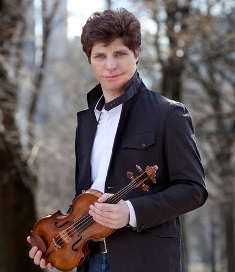
Lintu, Hadelich Make Impressive Debuts

Hannu Lintu
|
The forty-three-year-old Finn demonstrated power, presence and a polished technique, making him a more than credible candidate to fill music director Paavo Järvi’s shoes. He was joined in his CSO debut by another newcomer, violinist Augustin Hadelich, in a program that spanned the 18th to the 21st centuries, from Franz Joseph Haydn to Magnus Lindberg, with a delectable helping of Debussy in between.

Augustin Hadelich
|
Hadelich’s calling card was Haydn’s Violin Concerto
No. 1 in C Major, a work that spans baroque and classic styles, set for violin
and strings. He stole the audience’s
heart with it, producing a pure silken tone on his 1723 “Ex-Kiesewetter”
Stradivarius (on loan) and spinning phrases of silken texture to match. The genial first movement was capped by an
impressive cadenza (Hadelich’s own), while the Adagio sang sweetly in his hands
to pizzicato accompaniment by the CSO.
Heaven itself seemed to respond with an audible thunderclap between the Adagio and the Presto finale (from the storm brewing outside Music Hall). He, Lintu and the CSO proceeded with joyful dispatch, earning an enthusiastic standing ovation. In response, Hadelich performed an encore – no trifle, but the daunting 24th Caprice for Solo Violin by Nicolo Paganini, where he provided his own thunder and lightning.
There was more Haydn after intermission, his Symphony No. 100, the “Military,” so called for the use of percussion in the second movement. As so often with Haydn, it comes as a surprise, a kind of “Turkish” assault with triangle, cymbal and bass drum (associated then with Turkish music). The repeat “assault,” introduced by solo trumpet, as if on the field of battle, was vivid and aggressive, making one wonder if Haydn intended to make an anti-war statement.
Lintu drew exceedingly precise playing from the CSO, with clean articulation and pinpoint attacks throughout. There was plenty of character, too, as in the buoyant Menuetto and lickety-split finale (Presto). He is a conductor who gets his message across effectively and efficiently, while sparing no detail. He dispensed cues generously and acknowledged the contributions of all the players. He is fun to watch, too, very physical but not to excess. He allowed himself a flourish at the end of the symphony by twirling the baton over his head.
These observations were reinforced in Debussy’s “Iberia” from “Images.” The CSO sounded glorious in response to Lintu’s direction. He suffused it with color, spellbindingly so in “Les Parfums de la nuit” (“The perfumes of the night”), with its many-hued strings and woodwinds. The outer movements, “Par les rues et par les chemins” and “Le Matin d’un jour de féte” (“In the streets and by-ways” and “The morning of a festival day”) blazed with extravagance and intensity, and he went for a big finish at the end, slicing the air with his arm and spinning around towards the audience.
Lindberg’s “Feria” (1997) in its CSO premiere made a substantial opener to the concert. With “Iberia,” it gave the concert a Spanish theme, here, according to Lindberg’s program note, an outdoor festival or “feria.” (At 17 minutes, it is one of three Lindberg works that can be performed together as a symphony.) Recurring trumpet fanfares help give it unity. Scored for a huge orchestra, including a prominent part for piano (kudos to pianist Heather MacPhail), it falls into roughly three parts, a quieter mid-section enclosed by a boisterous beginning and a crashing, high decibel end. All were given strong, committed leadership by Lintu.
Note: With Järvi leaving the CSO in May, the beauty contest is on to find his successor. The guest conductor list is where he or she will be found and there are many possibilities (just eye next season’s lineup for starters). Much, if not most – as it should -- will depend on temperament and how the conductor relates to the orchestra members.
The concert repeats at 8 p.m. tonight at Music Hall. Tickets begin at $10, available by calling (513) 381-3300 or order online at www.cincinnatisymphony.org.